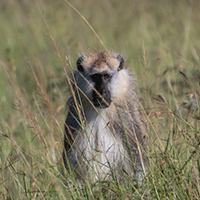
Southern patas monkey rediscovered!
NEWS!!
First Video of the ‘Critically Endangered’ Southern Patas Monkey
After Kruger National Park in South Africa, Serengeti National Park in northwestern Tanzania receives more tourists each year (about 500,000) than any other national park in Africa. Few of these many visitors are aware that there is a large mammal in Serengeti National Park that is seldom listed as being present, is infrequently encountered, and rarely photographed. This mammal is the Southern Patas Monkey (Erythrocebus baumstarki), a species that the IUCN Red List recognises as ‘Critically Endangered’. This monkey is profiled in Primates in Peril: The World’s 25 Most Endangered Primates 2023-2025.

Adult male Southern Patas Monkey (Erythrocebus baumstarki), Serengeti National Park. Photograph by Yvonne A. de Jong and Thomas M. Butynski.
The geographic range of this large (males 15 kg), semi-terrestrial, monkey has declined roughly 85% over the past 100 years to about 2,150 km² today, and probably numbers fewer than 200 individuals. Some conservationists feared that the Southern Patas Monkey might already be extinct, as it has been 2 years since the last reported observation. On 10 May 2025, however, we encountered a group of at least 14 Southern Patas Monkeys in the western Serengeti National Park. The videos taken might be the first of a social group of this species. Among the photographs are probably the first of the infants and juveniles of this species. Some of the videos are presented below.
If the above video does not open, please click here
Have you seen this monkey? Fantastic, please let us know and click here
Do you want to learn more about more about the Southern Patas Monkey and its plight, click here
Our research in the Serengeti Ecosystem is funded by EACOP’s Biodiversity Offsets Programme and supported by COSTECH, TAWIRI, and TANAPA. We thank all those who helped us during this survey.

Adult female Southern Patas Monkeys (Erythrocebus baumstarki) with infant, Serengeti National Park. Photograph by Yvonne A. de Jong and Thomas M. Butynski.

